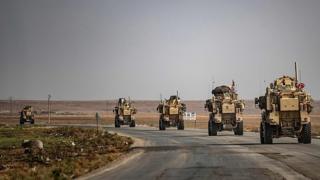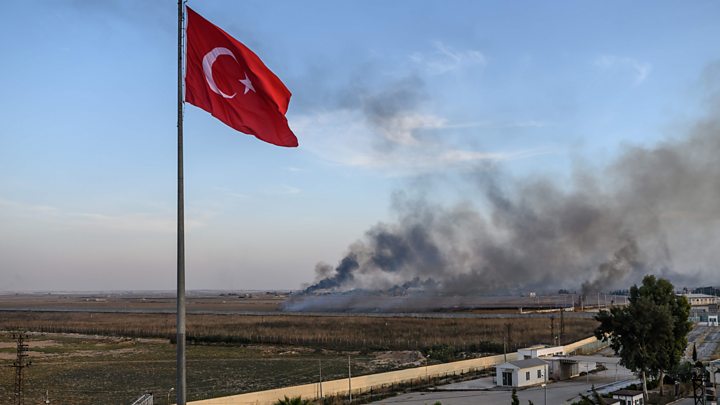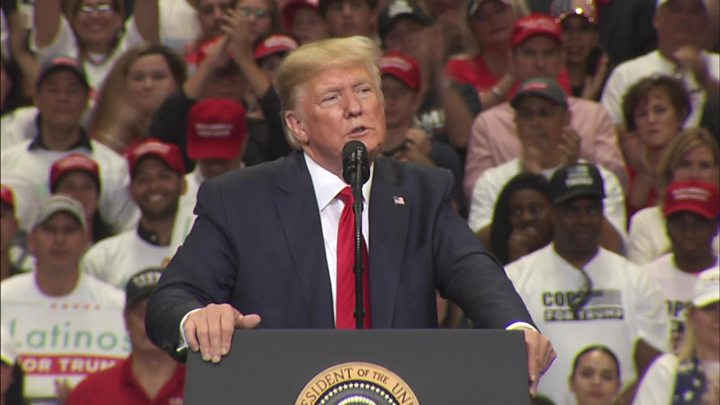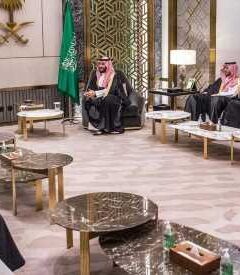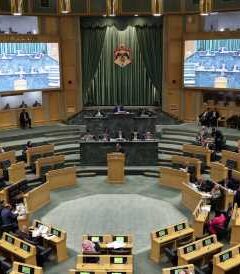Home » Middle East »
US troops leaving Syria will go to Iraq – official
All US troops withdrawing from northern Syria are expected to be relocated to western Iraq, Secretary of Defense Mark Esper confirmed.
Mr Esper told reporters that, under current plans, about 1,000 soldiers would be redeployed to help stop the resurgence of Islamic State (IS).
President Donald Trump has previously pledged to bring US troops home.
The US withdrawal from northern Syria paved the way for a Turkish military offensive against Kurdish fighters.
Both sides have accused the other of breaching a US-brokered ceasefire.
Ankara views one of the prominent militias in the Kurdish forces as terrorists, and wants to create a “safe zone” buffer inside Syria. Turkey agreed on Thursday to pause its offensive until Tuesday night, giving Kurdish fighters time to withdraw from the frontier.
On Sunday, Turkey said one of its soldiers was killed and another wounded in a Kurdish attack near the Syrian town of Tal Abyad.
In a separate development, a convoy of ambulances and pickups carrying Kurdish fighters was seen leaving the besieged town of Ras al-Ain on Sunday. Reports said pro-Turkish forces were now in control there.
Correspondents said it appeared to be the start of a wider withdrawal under the ceasefire agreement.
Some reports said civilians were also leaving because they feared atrocities by Syrian militias allied to Turkey.
Kurdish forces had previously accused Turkey of not allowing people to be evacuated from the border town.
Meanwhile, US House Speaker Nancy Pelosi and a bipartisan group of US lawmakers have arrived in Jordan for talks with King Abdullah.
Ms Pelosi, along with senior US politicians, has strongly criticised President Donald Trump’s decision to withdraw troops from northern Syria.
“With the deepening crisis in Syria after Turkey’s incursion, our delegation has engaged in vital discussions about the impact to regional stability, increased flow of refugees, and the dangerous opening that has been provided to Isis (IS), Iran and Russia,” she said in a statement.
What about US troops?
On a flight to the region, Mr Esper said US forces would be used to “help defend Iraq” and counter an attempt by IS to re-establish itself there.
“The US withdrawal continues apace from north-eastern Syria… we’re talking weeks, not days,” he said.
“The current game plan is for those forces to re-position into western Iraq.”
A senior US defence official cautioned that plans could change “but that is the game plan right now”.
In a tweet, later deleted, President Trump quoted Mr Esper – whom he referred to as Mark Esperanto – as saying that the ceasefire was “holding up very nicely”.
What about the ceasefire?
On Sunday, the Turkish defence ministry said a soldier was killed and another wounded by anti-tank and small arms fire near Tal Abyad.
It said Turkish forces returned fire in self-defence.
Earlier, Turkey’s defence ministry accused Kurdish forces of carrying out 14 “provocative” attacks in the last 36 hours, mostly in Ras al-Ain, but insisted Turkish forces were fully abiding by the agreement.
However, the Kurdish-led Syrian Democratic Forces (SDF) accused Turkey of violating the ceasefire and failing to create a safe corridor for the evacuation of civilians and wounded people from Ras al-Ain.
On Sunday, the UK-based Syrian Observatory for Human Rights (SOHR) monitoring group said ambulances transporting wounded civilians and fighters had been allowed to leave.
A reporter from AFP news agency at the scene said a hospital was engulfed in flames shortly after at least 50 vehicles, including ambulances, had left it.
Dozens of Kurdish fighters left on pick-up trucks which passed by checkpoints manned by pro-Turkish Syrian rebel fighters, the reporter said.
The SDF later confirmed that it had pulled out all its fighters. Syrian state media reported that pro-Turkish forces had entered the town.
The pause in hostilities followed talks in the Turkish capital Ankara between Turkish President Recep Tayyip Erdogan and US Vice-President Mike Pence on Thursday.
But Mr Erdogan has kept up a war of words on the Kurdish fighters. Speaking at a televised event in the central Turkish province of Kayseri on Saturday, he that if they did not withdraw by Tuesday evening “we will start where we left off and continue to crush the terrorists’ heads”.
Between 160,000 and 300,000 people have reportedly fled their homes since the offensive started 10 days ago.
SOHR said on Friday that the civilian death toll from the Turkish operation had risen to 86.
What prompted the offensive?
Turkish forces first launched their assault on 9 October, following an announcement that US troops would withdraw from the region.
The Turkish plan is to clear Kurdish fighters from a buffer zone extending more than 30km (20 miles) into Syria.
Turkey also plans to resettle up to two million Syrian refugees, currently on its territory, in the buffer zone but critics warned the move could trigger the ethnic cleansing of the local Kurdish population.
The goal was to push back a Kurdish militia group – the People’s Protection Units (YPG) – that Turkey views as a terrorist organisation.
Since the offensive was launched, President Trump has been accused by some, including senior Republicans, of abandoning a US ally. The SDF – a group dominated by the YPG – fought alongside the US against the Islamic State (IS) group in Syria.
Source: Read Full Article
